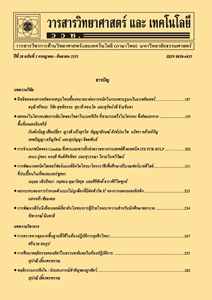City Carbon Footprint Evaluation, A Case Study: Muang Phayao Municipality
Main Article Content
Abstract
This research evaluated the emission of greenhouse gases (GHG) in Muang Phayao municipality area according to guidelines on city-level GHG emission by Thailand Greenhouse Gas Emission Organization (TGO). Related activity data for the year 2018 were collected, including energy consumption, waste management, agriculture and livestock production, electricity consumption, and other associated activities to determine significant GHG emission in Muang Phayao boundary. The results showed that electricity consumption from commercial and retail is the most prominent emission source at 49.23 percent, followed by fuel energy consumption at 33.26 percent, while open dump waste management amounts for 13.38 percent. Guidelines on reducing Muang Phayao municipality’s GHG emissions should be focused on reducing electricity and fuel energy consumption, and considering better waste management practices appropriate to Muang Phayao Municipality area’s contexts for efficient and sustainable GHG emission reduction.
Article Details
References
World Meteorological Organization, 2019, Greenhouse Gas Concentration Atmos phere Reach Yet Another High, Available Source: https://public.wmo.int/en/media/ press-release/greenhouse-gas-concentra tions-atmosphere-reach-yet-another-high, November 30, 2019.
TRF Policy Brief, 2013, Low Carbon Society: Development and Impetus Paradigm, Available Source: http://prp.trf.or.th/download/810, November 30, 2019. (in Thai)
Sununta, N., Sedpho, S. and Sampattagul, S., 2018, City carbon footprint evaluation and forecasting case study: Dan Sai municipality, Chem. Eng. Trans. 63: 277-282.
Nongsamrong Municipality, 2013, Greenhouse Gas Emission of Nongsamrong Municipality, Available Source: http://www.nongsamrong.go.th/files/gallerycontent/file-7465.pdf, December 2, 2019. (in Thai)
Xi, F., Geng, Y., Chen, X., Zhang, Y., Wang, X., Xue, B., Dong, H., Liu, Z., Ren, W., Fujita, T. and Zhu, Q., 2011, Contributing to local policy making on GHG emission reduction through inventorying and attribution: A case study of Shenyang, China, Energy Policy 39: 5999-6010.
Thailand Greenhouse Gas Management
Organization, 2020, Greenhouse Gas Emission in Local Administrative Organiza tions and Cities, Available Source: http://www.tgo.or.th/2015/thai/content.php?s1=56&s2=233&sub3=sub3, June 25, 2020. (in Thai)
Muang Phayao Municipality, 2018, Annual Performance Report of Muang Phayao Municipality 2018, Available Source: https://drive.google.com/file/d/14ctYIXSS5QMqBmjyNSZmrWrtrS4XHG3x/view, December 1, 2019. (in Thai)
Thailand Greenhouse Gas Management Organization, 2016, Guidelines for Assessing the Carbon Footprint of City, 2nd Ed., Available Source: http://conference.tgo.or.th/download/tgo_or_th/ccf/TGO_CCF_Ebook_V.Sep2559.pdf, January 2, 2020. (in Thai)
IPCC (Intergovernmental Panel on Climate Change), 2006, IPCC Guidelines for National Greenhouse Gas Inventories, Available Source: https://www.ipcc-nggip.iges.or.jp/public/2006gl/, December 2, 2019.
Chaivanich, K., 2020, Carbon footprint of an organization: A case study of the Department of Ordnance Engineering Academic Division, Chulachomklao Royal Military Academy, Rajabhat Nakhon Sawan J. Sci. Technol. 12(15): 48-57. (in Thai)
Sampattagul, S. and Khomyan, C., 2016, City Carbon Footprint Evaluation and GHG Mitigation Options Planning Survey for Low Carbon City, Conference Paper, Available Source: https://www.researchgate.net/publication/301732341_City_Carbon_Footprint_Evaluation_and_GHG_Mitigation_Options_Planning_Survey_for_Low_Carbon_City, June 25, 2020. (in Thai)
Coordinating Center for Energy Conserva tion Building Design, Department of Alternative Energy Department and Efficiency, Ministry of Energy, 2017, Guidelines for Building Design for Energy Conservation, Available Source: http://webkc.dede.go.th/testmax/sites/default/files/guidelinrBEC2017.pdf, December 2, 2019. (in Thai)
Lamrio, T., Klinpet, H. and Tantisattayakul, T., 2020, An energy efficiency improve ment opportunities of lighting system in lecture rooms: A case study of Faculty of Science and Technology, Thammasat University, Thai Sci. Technol. J. 28(7): 1309-1320. (in Thai)
Tantisattayakul, T., Rassameethamma chote, P. and Auisakul, M., 2017, Energy, environmental and economic assessment of solar rooftop systems on buildings of Thammasat University, Rangsit Centre, Thai Sci. Technol. J. 25(6): 1084-1099. (in Thai)
Ruengphol, S., 2016, Greenhouse Gas Emission from the Road Transportation Sector in Andaman Provinces, Thailand, Master’s Thesis, Prince of Songkla Univer sity, Songkla, 142 p. (in Thai)
Thailand Greenhouse Gas Management Organization (Public Organization), 2020, Carbon Footprint of Products (CFP) Emission Factors, Available Source: http://thaicarbonlabel.tgo.or.th/admin/uploadfiles/emission/ts_117a1351b6.pdf, January 5, 2020. (in Thai)
Thailand Greenhouse Gas Management Organization, 2016, Project proposal document “Tha Chiang Tong Landfill Gas Recovery for Electricity Generation”, Available Source: http://ghgreduction.tgo.or.th/tver-database-and-statistics/t-ver-registered-project/item/823-tha-chiang-tong-landfill-gas-recovery-for-electricity-generation.html, January 2, 2020. (in Thai)


